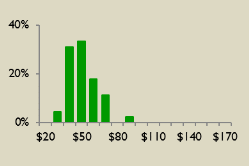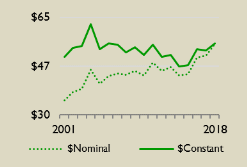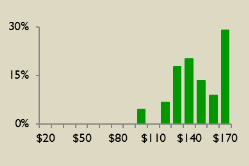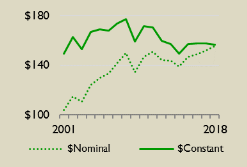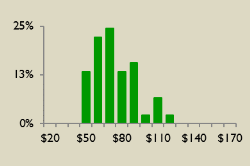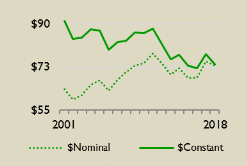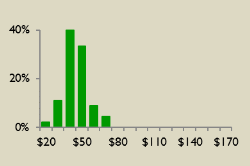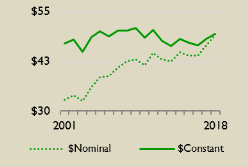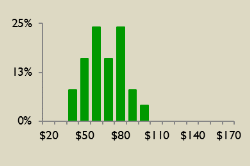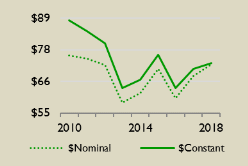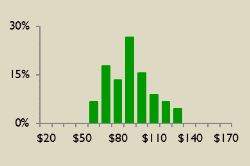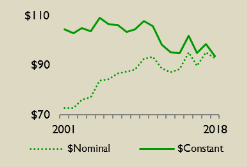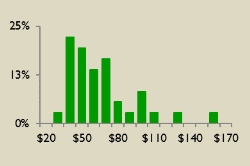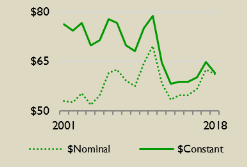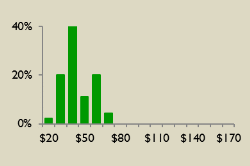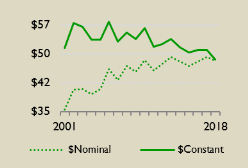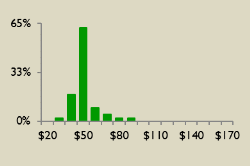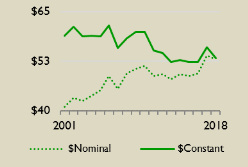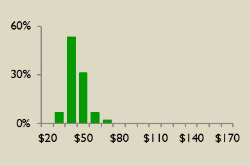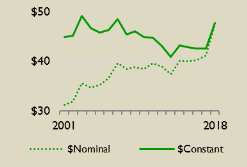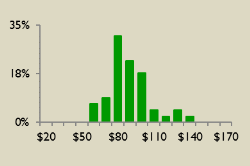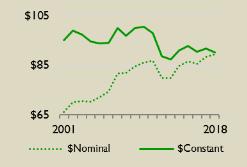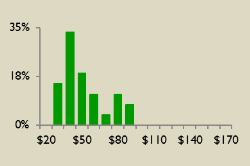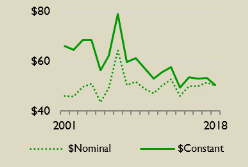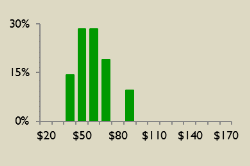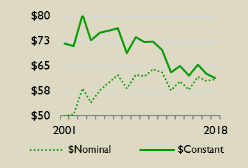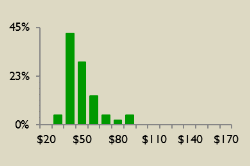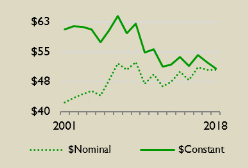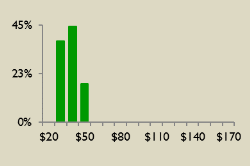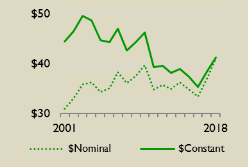Introduction
Levels of pay for congressional staff are a source of recurring questions among Members of Congress, congressional staff, and the public. Members of the House of Representatives typically set the terms and conditions of employment for staff in their offices. These include job titles, duties, and rates of pay, subject to a maximum level,1 and resources available to them to carry out their official duties.2 There may be interest in congressional pay data from multiple perspectives, including assessment of the costs of congressional operations; guidance in setting pay levels for staff in Member offices; or comparison of congressional staff pay levels with those of other federal government pay systems.
Publicly available resources do not provide aggregated congressional staff pay data in a readily retrievable form. The most recent, publicly available staff compensation report was issued in 2010,3 which, like previous compensation reports, relied on anonymous, self-reported survey data. Pay4 information in this report is based on the Statement of Disbursements of the House (SOD), published quarterly by the Chief Administrative Officer,5 as collated by LegiStorm, a private entity that provides some congressional data by subscription.6 Data in this report are based on official House reports, which afford the opportunity to use consistently collected data from a single, authoritative source. Additionally, this report provides annual data, which allows for observations about the nature of House Member staff compensation over time.
This report provides pay data for 15 staff position titles that are typically used in House Members' offices.7 The positions include the following:
- Caseworker8
- Chief of Staff
- Communications Director
- Constituent Services Representative
- Counsel9
- District Director
- Executive Assistant
- Field Representative
- Legislative Assistant
- Legislative Correspondent
- Legislative Director
- Office Manager
- Press Secretary
- Scheduler
- Staff Assistant
The collection of House Members' staff pay data for the years 2001-2018 proceeded as follows. For each year, a random sample10 of 45 offices was taken for each position. House staff had to hold a position with the same job title in the Member's office for the entire calendar year examined, and not receive pay from any other congressional employing authority to be included. Generally, each position has no more than one observation per House Member's office each year.
Every recorded payment ascribed in the LegiStorm data to those staff for the calendar year is included.11 Data collected for this report may differ from an employee's stated annual salary due to the inclusion of overtime, bonuses, or other payments12 in addition to base salary paid in the course of a year.
For some positions, it was not possible to identify 45 employees who held that title for the entire year. In circumstances when data for 18 or fewer staff were identified for a position, this report provides no data.
The Congressional Research Service provides a number of products on staffing issues. These can be found in CRS Report R44688, Congressional Staff: CRS Products on Size, Pay, and Job Tenure.
Data Concerns
There may be some advantages to relying on official salary expenditure data instead of survey findings, but data presented here are subject to some challenges that could affect the findings or their interpretation. Some of the concerns include the following:
- No data for first-term Members in the first session of a Congress. Authority to use the Member Representational Allowance (MRA) for the previous year expires January 2, and new MRA authority begins on January 3 when new Members typically take office.13
- The SOD reports monies paid directly by the House to staff, but does not provide the individual value of other components of compensation, which might include paid leave or employer contributions to various insurance and retirement benefits.
- Pay data provide no insight into the education, work experience, position tenure, full- or part-time status of staff, or other potential explanations for levels of compensation.
- Data do not differentiate between staff based in Washington, DC, district offices, or both.
- Member offices that do not utilize any of the 15 job position titles, or whose pay data were not reported consistently,14 are excluded.
- Potential differences could exist in the job duties of positions with the same title. Aggregation of pay by job title rests in part on the assumption that staff with the same title carry out similar tasks. Given the wide discretion congressional employing authorities have in setting the terms and conditions of employment, there may be differences in the duties of similarly titled staff that could have effects on their levels of pay.
Data Tables and Visualizations
Tables in this section provide background information on House pay practices, comparative data for each position, and detailed pay data and visualizations for each position. Table 1 provides the maximum payable rates for House Member staff since 2001 in both nominal (current) and constant 2019 dollars. Constant dollar calculations throughout the report are based on the Consumer Price Index for All Urban Consumers (CPI-U) for various years, expressed in constant 2019 dollars.15
Table 2 provides available percentage changes in median pay in constant 2019 dollars for each of the 15 positions, Members of Congress,16 salaries paid under the General Schedule in Washington, DC, and surrounding areas, and in the Rest of the United States (RUS) area.17 Table 3 through Table 17 provide tabular pay data for each staff position for 2001, 2004, 2009, and 2014-2018, including data distributed by quartile, including the median, and average pay. The numbers of staff for which data were counted are identified as "Number" in the data tables. Staff pay tables also provide a comparison, at various intervals to 2018, based on data availability, of the cumulative percentage change in median pay for that position, in constant, 2019 dollars.
Graphic displays are also included for each position, providing representations of pay from two perspectives, including the following:
- distributions of 2018 pay in 2019 dollars, in $10,000 increments; and
- a line graph showing change in median pay, 2001-2018, in nominal (current) and constant 2019 dollars.
|
Year |
Nominal $ |
Constant 2019 $ |
|
2001 |
$140,451 |
$201,598 |
|
2002 |
$145,226 |
$205,207 |
|
2003 |
$149,728 |
$206,854 |
|
2004 |
$153,022 |
$205,921 |
|
2005 |
$156,848 |
$204,153 |
|
2006 |
$159,828 |
$201,531 |
|
2007 |
$159,828 |
$195,950 |
|
2008 |
$163,795 |
$193,388 |
|
2009 |
$168,411 |
$199,548 |
|
2010 |
$168,411 |
$196,328 |
|
2011 |
$168,411 |
$190,320 |
|
2012 |
$168,411 |
$186,461 |
|
2013 |
$168,411 |
$183,770 |
|
2014 |
$168,411 |
$180,836 |
|
2015 |
$168,411 |
$180,622 |
|
2016 |
$168,411 |
$178,372 |
|
2017 |
$168,411 |
$174,649 |
|
2018 |
$168,411 |
$170,487 |
|
2019 |
$168,411 |
$168,411 |
Source: 2 U.S.C. 4532 note, CRS calculations. Detailed information about data sources is available above in "Data Tables and Visualizations."
|
Change Based on Constant 2019 Dollars |
|||||
|
2017-2018 |
2014-2018 |
2009-2018 |
2004-2018 |
2001-2018 |
|
|
Caseworker |
4.68% |
17.35% |
2.75% |
-10.79% |
9.49% |
|
Chief of Staff |
-0.61% |
4.99% |
-1.58% |
-6.11% |
4.70% |
|
Communications Director |
-5.52% |
-5.03% |
-15.00% |
-16.31% |
-19.45% |
|
Constituent Services Representative |
2.60% |
2.85% |
-2.73% |
1.85% |
5.12% |
|
Counsel |
2.75% |
8.93% |
-9.63% |
— |
— |
|
District Director |
-5.15% |
-1.49% |
-10.49% |
-9.77% |
-10.46% |
|
Executive Assistant |
-4.97% |
4.93% |
-9.46% |
-11.74% |
-19.12% |
|
Field Representative |
-4.92% |
-6.09% |
-9.85% |
-9.51% |
-5.67% |
|
Legislative Assistant |
-4.88% |
0.79% |
-10.98% |
-9.52% |
-9.69% |
|
Legislative Correspondent |
12.03% |
10.68% |
3.81% |
2.34% |
6.39% |
|
Legislative Director |
-1.83% |
-0.96% |
-9.93% |
-4.76% |
-5.26% |
|
Office Manager |
-5.37% |
2.07% |
-17.89% |
-26.54% |
-23.92% |
|
Press Secretary |
-2.20% |
-5.42% |
-16.69% |
-15.50% |
-14.44% |
|
Scheduler |
-2.93% |
-5.31% |
-18.20% |
-16.24% |
-16.24% |
|
Staff Assistant |
7.39% |
6.10% |
-7.07% |
-15.29% |
-7.19% |
|
Members of Congress |
-2.38% |
-5.72% |
-14.56% |
-17.21% |
-15.43% |
|
General Schedule, DC |
-0.14% |
1.66% |
-4.77% |
1.16% |
8.19% |
|
General Schedule, Rest of U.S. |
-0.75% |
-0.46% |
-7.29% |
-5.91% |
-0.34% |
|
Congressional Staff Positions |
|||||
|
Increase |
5 |
9 |
2 |
2 |
4 |
|
Decrease |
10 |
6 |
13 |
12 |
10 |
Source: CRS calculations, based on pay data provided in Table 3 through Table 17 for congressional positions in constant 2019 dollars; CRS Report 97-1011, Salaries of Members of Congress: Recent Actions and Historical Tables, by Ida A. Brudnick, for Members of Congress; and the Office of Personnel Management for federal civilian workers in the District of Columbia and surrounding areas, and rest of the U.S., various years. Detailed information about data sources is available above in "Data Tables and Visualizations."
House Member Office Staff Pay Tables
|
Interpreting Pay Tables: Statistics Describing Pay Data For each year that data are available, statistical values for staff positions are included in Table 3 through Table 17, including the following:
Statistical Measures Used in Pay Tables
|
|
Nominal, Current $ |
Constant, 2019, $ |
||||||||||||||||
|
Year |
Number |
Minimum |
Q1 |
Q2, Median |
Q3 |
Maximum |
Average |
Minimum |
Q1 |
Q2, Median |
Q3 |
Maximum |
Average |
||||
|
2001 |
45 |
$21,750 |
$30,000 |
$35,229 |
$40,122 |
$61,572 |
$36,189 |
$31,219 |
$43,061 |
$50,567 |
$57,590 |
$88,377 |
$51,945 |
||||
|
2004 |
45 |
$28,333 |
$37,804 |
$46,120 |
$50,000 |
$63,900 |
$44,992 |
$38,128 |
$50,873 |
$62,064 |
$67,285 |
$85,990 |
$60,545 |
||||
|
2009 |
45 |
$28,919 |
$38,750 |
$45,475 |
$53,375 |
$86,210 |
$47,751 |
$34,266 |
$45,914 |
$53,883 |
$63,243 |
$102,149 |
$56,580 |
||||
|
Most Recent Five Years |
|||||||||||||||||
|
2014 |
45 |
$27,833 |
$40,075 |
$43,937 |
$51,000 |
$85,000 |
$46,984 |
$29,887 |
$43,032 |
$47,179 |
$54,763 |
$91,271 |
$50,451 |
||||
|
2015 |
45 |
$28,000 |
$40,058 |
$44,500 |
$54,500 |
$84,667 |
$48,081 |
$30,030 |
$42,963 |
$47,726 |
$58,452 |
$90,806 |
$51,567 |
||||
|
2016 |
45 |
$29,667 |
$40,544 |
$50,300 |
$56,837 |
$89,100 |
$50,290 |
$31,421 |
$42,942 |
$53,275 |
$60,198 |
$94,370 |
$53,265 |
||||
|
2017 |
45 |
$30,000 |
$42,750 |
$51,000 |
$58,000 |
$92,567 |
$51,283 |
$31,111 |
$44,333 |
$52,889 |
$60,148 |
$95,995 |
$53,182 |
||||
|
2018 |
45 |
$35,000 |
$47,500 |
$55,000 |
$64,000 |
$94,036 |
$55,985 |
$35,233 |
$47,816 |
$55,366 |
$64,425 |
$94,661 |
$56,357 |
||||
|
2018 Pay Distribution |
Median Pay |
Change |
|||||||||||||||
|
|
|
2017-2018 2014-2018 2009-2018 2004-2018 2001-2018 |
4.68% 17.35% 2.75% -10.79% 9.49% |
||||||||||||||
|
Dollars in figures are in thousands. |
|||||||||||||||||
Source: Statement of Disbursements of the House, as collated by LegiStorm, various years, and CRS calculations. Percentage change in pay is based on the change in median pay (expressed in constant, March 2019 dollars) for the periods noted. In the visualizations, position pay information based on constant 2019 dollars in thousands of dollars, or change in those levels, are presented in solid green. Detailed information about data sources is available above in "Data Tables and Visualizations." Data provided here are partial; complete data, 2001-2018, are available to congressional requesters upon request.
|
Nominal, Current $ |
Constant, 2019, $ |
||||||||||||||||
|
Year |
Number |
Minimum |
Q1 |
Q2, Median |
Q3 |
Maximum |
Average |
Minimum |
Q1 |
Q2, Median |
Q3 |
Maximum |
Average |
||||
|
2001 |
45 |
$76,361 |
$95,000 |
$104,250 |
$114,833 |
$137,020 |
$106,313 |
$109,606 |
$136,359 |
$149,636 |
$164,827 |
$196,673 |
$152,598 |
||||
|
2004 |
45 |
$86,500 |
$110,952 |
$124,000 |
$134,524 |
$151,974 |
$122,278 |
$116,403 |
$149,307 |
$166,866 |
$181,029 |
$204,511 |
$164,549 |
||||
|
2009 |
45 |
$42,708 |
$123,350 |
$134,344 |
$153,136 |
$168,411 |
$133,877 |
$50,605 |
$146,156 |
$159,183 |
$181,449 |
$199,548 |
$158,629 |
||||
|
Most Recent Five Years |
|||||||||||||||||
|
2014 |
45 |
$89,401 |
$124,167 |
$138,968 |
$161,091 |
$168,411 |
$140,803 |
$95,997 |
$133,328 |
$149,221 |
$172,975 |
$180,836 |
$151,191 |
||||
|
2015 |
45 |
$114,173 |
$137,924 |
$146,561 |
$160,000 |
$168,411 |
$147,650 |
$122,451 |
$147,925 |
$157,188 |
$171,601 |
$180,622 |
$158,356 |
||||
|
2016 |
45 |
$116,534 |
$133,820 |
$148,902 |
$159,700 |
$168,411 |
$147,637 |
$123,427 |
$141,735 |
$157,708 |
$169,145 |
$178,372 |
$156,369 |
||||
|
2017 |
45 |
$112,320 |
$139,444 |
$152,000 |
$160,834 |
$168,411 |
$150,185 |
$116,480 |
$144,609 |
$157,630 |
$166,791 |
$174,649 |
$155,748 |
||||
|
2018 |
45 |
$99,917 |
$137,000 |
$155,637 |
$168,000 |
$168,411 |
$149,871 |
$100,581 |
$137,911 |
$156,671 |
$169,117 |
$169,530 |
$150,867 |
||||
|
2018 Pay Distribution |
Median Pay |
Change |
|||||||||||||||
|
|
|
2017-2018 2014-2018 2009-2018 2004-2018 2001-2018 |
-0.61% 4.99% -1.58% -6.11% 4.70% |
||||||||||||||
|
Dollars in figures are in thousands. |
|||||||||||||||||
Source: Statement of Disbursements of the House, as collated by LegiStorm, various years, and CRS calculations. Percentage change in pay is based on the change in median pay (expressed in constant, March 2019 dollars) for the periods noted. In the visualizations, position pay information based on constant 2019 dollars in thousands of dollars, or change in those levels, are presented in solid green. Detailed information about data sources is available above in "Data Tables and Visualizations." Data provided here are partial; complete data, 2001-2018, are available to congressional requesters upon request.
|
Nominal, Current $ |
Constant, 2019, $ |
||||||||||||||||
|
Year |
Number |
Minimum |
Q1 |
Q2, Median |
Q3 |
Maximum |
Average |
Minimum |
Q1 |
Q2, Median |
Q3 |
Maximum |
Average |
||||
|
2001 |
32 |
$35,233 |
$51,118 |
$63,563 |
$72,000 |
$99,020 |
$63,538 |
$50,573 |
$73,372 |
$91,235 |
$103,346 |
$142,129 |
$91,200 |
||||
|
2004 |
45 |
$39,000 |
$56,489 |
$65,250 |
$69,567 |
$106,690 |
$65,201 |
$52,482 |
$76,017 |
$87,807 |
$93,616 |
$143,572 |
$87,740 |
||||
|
2009 |
45 |
$48,233 |
$64,617 |
$72,961 |
$83,273 |
$128,992 |
$77,048 |
$57,151 |
$76,563 |
$86,451 |
$98,670 |
$152,841 |
$91,293 |
||||
|
Most Recent Five Years |
|||||||||||||||||
|
2014 |
45 |
$42,500 |
$63,000 |
$72,061 |
$82,000 |
$115,000 |
$72,485 |
$45,636 |
$67,648 |
$77,378 |
$88,050 |
$123,484 |
$77,833 |
||||
|
2015 |
45 |
$43,878 |
$61,678 |
$68,078 |
$77,937 |
$102,918 |
$70,327 |
$47,059 |
$66,150 |
$73,014 |
$83,588 |
$110,380 |
$75,427 |
||||
|
2016 |
45 |
$48,000 |
$58,546 |
$68,125 |
$82,680 |
$120,300 |
$73,690 |
$50,839 |
$62,008 |
$72,154 |
$87,570 |
$127,415 |
$78,048 |
||||
|
2017 |
45 |
$46,500 |
$69,000 |
$75,000 |
$84,250 |
$106,733 |
$76,784 |
$48,222 |
$71,556 |
$77,778 |
$87,371 |
$110,687 |
$79,628 |
||||
|
2018 |
45 |
$52,000 |
$63,333 |
$73,001 |
$89,986 |
$124,000 |
$77,436 |
$52,346 |
$63,754 |
$73,486 |
$90,584 |
$124,824 |
$77,951 |
||||
|
2018 Pay Distribution |
Median Pay |
Change |
|||||||||||||||
|
|
|
2017-2018 2014-2018 2009-2018 2004-2018 2001-2018 |
-5.52% -5.03% -15.00% -16.31% -19.45% |
||||||||||||||
|
Dollars in figures are in thousands. |
|||||||||||||||||
Source: Statement of Disbursements of the House, as collated by LegiStorm, various years, and CRS calculations. Percentage change in pay is based on the change in median pay (expressed in constant, March 2019 dollars) for the periods noted. In the visualizations, position pay information based on constant 2019 dollars in thousands of dollars, or change in those levels, are presented in solid blue. Detailed information about data sources is available above in "Data Tables and Visualizations." Data provided here are partial; complete data, FY2001-FY2018, is available to congressional requesters upon request.
|
Nominal, Current $ |
Constant, 2019, $ |
||||||||||||||||
|
Year |
Number |
Minimum |
Q1 |
Q2, Median |
Q3 |
Maximum |
Average |
Minimum |
Q1 |
Q2, Median |
Q3 |
Maximum |
Average |
||||
|
2001 |
30 |
$25,894 |
$28,789 |
$32,791 |
$37,401 |
$46,880 |
$33,815 |
$37,168 |
$41,322 |
$47,067 |
$53,684 |
$67,290 |
$48,537 |
||||
|
2004 |
45 |
$24,247 |
$30,300 |
$36,100 |
$42,667 |
$63,333 |
$36,983 |
$32,629 |
$40,775 |
$48,580 |
$57,416 |
$85,227 |
$49,768 |
||||
|
2009 |
45 |
$27,125 |
$33,833 |
$42,928 |
$52,000 |
$86,558 |
$43,815 |
$32,140 |
$40,089 |
$50,865 |
$61,614 |
$102,562 |
$51,915 |
||||
|
Most Recent Five Years |
|||||||||||||||||
|
2014 |
45 |
$26,250 |
$35,000 |
$44,800 |
$50,833 |
$88,833 |
$46,912 |
$28,187 |
$37,582 |
$48,105 |
$54,584 |
$95,387 |
$50,373 |
||||
|
2015 |
45 |
$28,500 |
$36,000 |
$44,000 |
$50,322 |
$77,250 |
$44,186 |
$30,566 |
$38,610 |
$47,190 |
$53,971 |
$82,851 |
$47,389 |
||||
|
2016 |
45 |
$22,903 |
$39,775 |
$44,000 |
$56,400 |
$74,417 |
$46,874 |
$24,257 |
$42,127 |
$46,602 |
$59,736 |
$78,818 |
$49,647 |
||||
|
2017 |
45 |
$20,425 |
$41,000 |
$46,500 |
$52,500 |
$64,000 |
$47,104 |
$21,182 |
$42,519 |
$48,222 |
$54,445 |
$66,371 |
$48,849 |
||||
|
2018 |
45 |
$23,833 |
$42,925 |
$49,150 |
$54,972 |
$73,567 |
$49,145 |
$23,992 |
$43,210 |
$49,477 |
$55,338 |
$74,056 |
$49,472 |
||||
|
2018 Pay Distribution |
Median Pay |
Change |
|||||||||||||||
|
|
|
2017-2018 2014-2018 2009-2018 2004-2018 2001-2018 |
2.60% 2.85% -2.73% 1.85% 5.12% |
||||||||||||||
|
Dollars in figures are in thousands. |
|||||||||||||||||
Source: Statement of Disbursements of the House, as collated by LegiStorm, various years, and CRS calculations. Percentage change in pay is based on the change in median pay (expressed in constant, March 2019 dollars) for the periods noted. In the visualizations, position pay information based on constant 2019 dollars in thousands of dollars, or change in those levels, are presented in solid green. Detailed information about data sources is available above in "Data Tables and Visualizations." Data provided here are partial; complete data, 2001-2018, are available to congressional requesters upon request.
|
Nominal, Current $ |
Constant, 2019, $ |
||||||||||||||||
|
Year |
Number |
Minimum |
Q1 |
Q2, Median |
Q3 |
Maximum |
Average |
Minimum |
Q1 |
Q2, Median |
Q3 |
Maximum |
Average |
||||
|
2010 |
30 |
$45,250 |
$61,013 |
$75,502 |
$87,724 |
$127,981 |
$76,884 |
$52,751 |
$71,126 |
$88,017 |
$102,266 |
$149,196 |
$89,628 |
||||
|
2011 |
23 |
$34,792 |
$58,250 |
$74,417 |
$79,500 |
$100,375 |
$70,824 |
$39,318 |
$65,828 |
$84,098 |
$89,842 |
$113,433 |
$80,038 |
||||
|
2012 |
20 |
$49,236 |
$60,804 |
$72,167 |
$81,640 |
$130,833 |
$73,390 |
$54,513 |
$67,321 |
$79,902 |
$90,390 |
$144,856 |
$81,256 |
||||
|
2013 |
19 |
$41,667 |
$51,125 |
$58,692 |
$71,750 |
$126,546 |
$63,416 |
$45,467 |
$55,787 |
$64,044 |
$78,293 |
$138,087 |
$69,199 |
||||
|
2014 |
19 |
$45,200 |
$52,917 |
$62,250 |
$77,500 |
$119,868 |
$67,088 |
$48,535 |
$56,821 |
$66,843 |
$83,218 |
$128,711 |
$72,038 |
||||
|
2015 |
23 |
$41,000 |
$61,000 |
$70,678 |
$80,324 |
$108,142 |
$71,155 |
$43,973 |
$65,423 |
$75,802 |
$86,148 |
$115,983 |
$76,314 |
||||
|
2016 |
28 |
$44,500 |
$53,425 |
$60,333 |
$68,000 |
$91,097 |
$61,538 |
$47,132 |
$56,585 |
$63,902 |
$72,022 |
$96,485 |
$65,178 |
||||
|
2017 |
21 |
$29,000 |
$52,000 |
$68,333 |
$77,841 |
$88,000 |
$64,413 |
$30,074 |
$53,926 |
$70,864 |
$80,725 |
$91,259 |
$66,799 |
||||
|
2018 |
25 |
$46,000 |
$61,750 |
$72,333 |
$81,333 |
$99,000 |
$70,871 |
$46,306 |
$62,160 |
$72,814 |
$81,874 |
$99,658 |
$71,342 |
||||
|
2018 Pay Distribution |
Median Pay |
Change |
|||||||||||||||
|
|
|
2017-2018 2014-2018 |
2.75% 8.93% |
||||||||||||||
|
Dollars in figures are in thousands. |
|||||||||||||||||
Source: Statement of Disbursements of the House, as collated by LegiStorm, various years, and CRS calculations. Percentage change in pay is based on the change in median pay (expressed in constant, March 2019 dollars) for the periods noted. In the visualizations, position pay information based on constant 2019 dollars in thousands of dollars, or change in those levels, are presented in solid green. Detailed information about data sources is available above in "Data Tables and Visualizations." Data provided here are complete; no data are available prior to 2010.
|
Nominal, Current $ |
Constant, 2019, $ |
||||||||||||||||
|
Year |
Number |
Minimum |
Q1 |
Q2, Median |
Q3 |
Maximum |
Average |
Minimum |
Q1 |
Q2, Median |
Q3 |
Maximum |
Average |
||||
|
2001 |
45 |
$49,538 |
$58,667 |
$72,844 |
$78,240 |
$101,624 |
$70,062 |
$71,105 |
$84,208 |
$104,558 |
$112,302 |
$145,867 |
$100,564 |
||||
|
2004 |
45 |
$42,500 |
$70,750 |
$77,100 |
$83,050 |
$116,568 |
$77,877 |
$57,192 |
$95,208 |
$103,753 |
$111,760 |
$156,865 |
$104,799 |
||||
|
2009 |
45 |
$60,000 |
$80,680 |
$88,274 |
$98,115 |
$120,450 |
$90,238 |
$71,093 |
$95,597 |
$104,595 |
$116,255 |
$142,720 |
$106,922 |
||||
|
Most Recent Five Years |
|||||||||||||||||
|
2014 |
45 |
$45,000 |
$75,400 |
$88,500 |
$107,083 |
$144,667 |
$93,519 |
$48,320 |
$80,963 |
$95,029 |
$114,984 |
$155,340 |
$100,419 |
||||
|
2015 |
45 |
$59,433 |
$78,000 |
$95,167 |
$112,000 |
$162,600 |
$97,911 |
$63,743 |
$83,655 |
$102,067 |
$120,121 |
$174,389 |
$105,010 |
||||
|
2016 |
45 |
$58,417 |
$79,500 |
$89,750 |
$105,917 |
$145,265 |
$94,988 |
$61,872 |
$84,202 |
$95,058 |
$112,181 |
$153,856 |
$100,606 |
||||
|
2017 |
45 |
$56,000 |
$85,638 |
$95,172 |
$105,000 |
$163,028 |
$97,105 |
$58,074 |
$88,810 |
$98,697 |
$108,889 |
$169,066 |
$100,701 |
||||
|
2018 |
45 |
$62,200 |
$81,250 |
$93,000 |
$105,000 |
$138,000 |
$94,042 |
$62,613 |
$81,790 |
$93,618 |
$105,698 |
$138,917 |
$94,667 |
||||
|
2018 Pay Distribution |
Median Pay |
Change |
|||||||||||||||
|
|
|
2017-2018 2014-2018 2009-2018 2004-2018 2001-2018 |
-5.15% -1.49% -10.49% -9.77% -10.46% |
||||||||||||||
|
Dollars in figures are in thousands. |
|||||||||||||||||
Source: Statement of Disbursements of the House, as collated by LegiStorm, various years, and CRS calculations. Percentage change in pay is based on the change in median pay (expressed in constant, March 2019 dollars) for the periods noted. In the visualizations, position pay information based on constant 2019 dollars in thousands of dollars, or change in those levels, are presented in solid green. Detailed information about data sources is available above in "Data Tables and Visualizations." Data provided here are partial; complete data, 2001-2018, are available to congressional requesters upon request.
|
Nominal, Current $ |
Constant, 2019, $ |
||||||||||||||||
|
Year |
Number |
Minimum |
Q1 |
Q2, Median |
Q3 |
Maximum |
Average |
Minimum |
Q1 |
Q2, Median |
Q3 |
Maximum |
Average |
||||
|
2001 |
45 |
$27,583 |
$44,750 |
$53,136 |
$65,917 |
$104,167 |
$56,922 |
$39,592 |
$64,232 |
$76,269 |
$94,614 |
$149,517 |
$81,704 |
||||
|
2004 |
45 |
$27,446 |
$41,957 |
$51,933 |
$68,600 |
$87,602 |
$55,603 |
$36,934 |
$56,461 |
$69,887 |
$92,315 |
$117,885 |
$74,824 |
||||
|
2009 |
45 |
$30,000 |
$46,000 |
$57,500 |
$66,000 |
$108,047 |
$58,062 |
$35,547 |
$54,505 |
$68,131 |
$78,203 |
$128,023 |
$68,796 |
||||
|
Most Recent Five Years |
|||||||||||||||||
|
2014 |
30 |
$32,000 |
$46,625 |
$54,750 |
$64,612 |
$89,167 |
$55,748 |
$34,361 |
$50,065 |
$58,789 |
$69,379 |
$95,745 |
$59,861 |
||||
|
2015 |
38 |
$21,000 |
$44,412 |
$54,917 |
$66,125 |
$92,426 |
$55,918 |
$22,523 |
$47,633 |
$58,898 |
$70,919 |
$99,127 |
$59,973 |
||||
|
2016 |
42 |
$21,000 |
$48,667 |
$56,799 |
$64,768 |
$93,291 |
$57,936 |
$22,242 |
$51,545 |
$60,158 |
$68,599 |
$98,808 |
$61,362 |
||||
|
2017 |
28 |
$21,000 |
$49,125 |
$62,590 |
$73,845 |
$96,500 |
$61,742 |
$21,778 |
$50,945 |
$64,908 |
$76,580 |
$100,074 |
$64,028 |
||||
|
2018 |
34 |
$35,041 |
$49,250 |
$61,278 |
$78,246 |
$166,137 |
$67,677 |
$35,274 |
$49,577 |
$61,685 |
$78,766 |
$167,241 |
$68,127 |
||||
|
2018 Pay Distribution |
Median Pay |
Change |
|||||||||||||||
|
|
|
2017-2018 2014-2018 2009-2018 2004-2018 2001-2018 |
-4.97% 4.93% -9.46% -11.74% -19.12% |
||||||||||||||
|
Dollars in figures are in thousands. |
|||||||||||||||||
Source: Statement of Disbursements of the House, as collated by LegiStorm, various years, and CRS calculations. Percentage change in pay is based on the change in median pay (expressed in constant, March 2019 dollars) for the periods noted. In the visualizations, position pay information based on constant 2019 dollars in thousands of dollars, or change in those levels, are presented in solid green. Detailed information about data sources is available above in "Data Tables and Visualizations." Data provided here are partial; complete data, 2001-2018, are available to congressional requesters upon request.
|
Nominal, Current $ |
Constant, 2019, $ |
||||||||||||||||
|
Year |
Number |
Minimum |
Q1 |
Q2, Median |
Q3 |
Maximum |
Average |
Minimum |
Q1 |
Q2, Median |
Q3 |
Maximum |
Average |
||||
|
2001 |
45 |
$22,131 |
$31,250 |
$35,500 |
$40,795 |
$75,275 |
$38,242 |
$31,765 |
$44,855 |
$50,955 |
$58,555 |
$108,047 |
$54,891 |
||||
|
2004 |
45 |
$26,017 |
$35,558 |
$39,472 |
$49,000 |
$78,967 |
$42,892 |
$35,011 |
$47,851 |
$53,117 |
$65,939 |
$106,265 |
$57,719 |
||||
|
2009 |
45 |
$34,033 |
$40,300 |
$45,000 |
$51,021 |
$81,917 |
$47,299 |
$40,326 |
$47,751 |
$53,320 |
$60,455 |
$97,062 |
$56,044 |
||||
|
Most Recent Five Years |
|||||||||||||||||
|
2014 |
45 |
$25,750 |
$42,000 |
$47,667 |
$55,417 |
$94,625 |
$48,428 |
$27,650 |
$45,099 |
$51,183 |
$59,505 |
$101,606 |
$52,001 |
||||
|
2015 |
45 |
$22,100 |
$40,994 |
$46,544 |
$55,000 |
$100,000 |
$49,031 |
$23,702 |
$43,967 |
$49,919 |
$58,988 |
$107,251 |
$52,586 |
||||
|
2016 |
45 |
$25,000 |
$39,050 |
$47,667 |
$56,250 |
$71,890 |
$48,188 |
$26,479 |
$41,360 |
$50,486 |
$59,577 |
$76,142 |
$51,038 |
||||
|
2017 |
45 |
$21,500 |
$44,500 |
$48,750 |
$57,489 |
$81,400 |
$50,091 |
$22,296 |
$46,148 |
$50,556 |
$59,618 |
$84,415 |
$51,946 |
||||
|
2018 |
45 |
$29,250 |
$41,000 |
$47,750 |
$54,750 |
$72,128 |
$48,707 |
$29,444 |
$41,272 |
$48,067 |
$55,114 |
$72,607 |
$49,031 |
||||
|
2018 Pay Distribution |
Median Pay |
Change |
|||||||||||||||
|
|
|
2017-2018 2014-2018 2009-2018 2004-2018 2001-2018 |
-4.92% -6.09% -9.85% -9.51% -5.67% |
||||||||||||||
|
Dollars in figures are in thousands. |
|||||||||||||||||
Source: Statement of Disbursements of the House, as collated by LegiStorm, various years, and CRS calculations. Percentage change in pay is based on the change in median pay (expressed in constant, March 2019 dollars) for the periods noted. In the visualizations, position pay information based on constant 2019 dollars in thousands of dollars, or change in those levels, are presented in solid green. Detailed information about data sources is available above in "Data Tables and Visualizations." Data provided here are partial; complete data, 2001-2018, are available to congressional requesters upon request.
|
Nominal, Current $ |
Constant, 2019, $ |
||||||||||||||||
|
Year |
Number |
Minimum |
Q1 |
Q2, Median |
Q3 |
Maximum |
Average |
Minimum |
Q1 |
Q2, Median |
Q3 |
Maximum |
Average |
||||
|
2001 |
45 |
$30,154 |
$37,748 |
$41,092 |
$45,676 |
$70,000 |
$43,493 |
$43,282 |
$54,182 |
$58,981 |
$65,561 |
$100,475 |
$62,428 |
||||
|
2004 |
45 |
$30,081 |
$37,813 |
$43,750 |
$49,242 |
$95,585 |
$46,008 |
$40,479 |
$50,884 |
$58,874 |
$66,264 |
$128,628 |
$61,913 |
||||
|
2009 |
45 |
$34,000 |
$44,595 |
$50,500 |
$54,950 |
$63,500 |
$49,982 |
$40,286 |
$52,840 |
$59,837 |
$65,110 |
$75,240 |
$59,223 |
||||
|
Most Recent Five Years |
|||||||||||||||||
|
2014 |
45 |
$31,333 |
$44,667 |
$49,219 |
$55,400 |
$90,833 |
$50,854 |
$33,645 |
$47,962 |
$52,851 |
$59,487 |
$97,535 |
$54,606 |
||||
|
2015 |
45 |
$30,000 |
$43,850 |
$48,760 |
$52,667 |
$83,336 |
$49,860 |
$32,175 |
$47,029 |
$52,296 |
$56,485 |
$89,378 |
$53,476 |
||||
|
2016 |
45 |
$36,896 |
$46,500 |
$49,400 |
$59,583 |
$72,967 |
$52,276 |
$39,078 |
$49,250 |
$52,322 |
$63,107 |
$77,282 |
$55,367 |
||||
|
2017 |
45 |
$41,746 |
$48,833 |
$54,000 |
$60,961 |
$91,033 |
$56,951 |
$43,292 |
$50,642 |
$56,000 |
$63,219 |
$94,405 |
$59,061 |
||||
|
2018 |
45 |
$37,163 |
$50,000 |
$52,917 |
$57,500 |
$96,417 |
$55,304 |
$37,410 |
$50,332 |
$53,268 |
$57,882 |
$97,058 |
$55,672 |
||||
|
2018 Pay Distribution |
Median Pay |
Change |
|||||||||||||||
|
|
|
2017-2018 2014-2018 2009-2018 2004-2018 2001-2018 |
-4.88% 0.79% -10.98% -9.52% -9.69% |
||||||||||||||
|
Dollars in figures are in thousands. |
|||||||||||||||||
Source: Statement of Disbursements of the House, as collated by LegiStorm, various years, and CRS calculations. Percentage change in pay is based on the change in median pay (expressed in constant, March 2019 dollars) for the periods noted. In the visualizations, position pay information based on constant 2019 dollars in thousands of dollars, or change in those levels, are presented in solid green. Detailed information about data sources is available above in "Data Tables and Visualizations." Data provided here are partial; complete data, 2001-2018, are available to congressional requesters upon request.
|
Nominal, Current $ |
Constant, 2019, $ |
||||||||||||||||
|
Year |
Number |
Minimum |
Q1 |
Q2, Median |
Q3 |
Maximum |
Average |
Minimum |
Q1 |
Q2, Median |
Q3 |
Maximum |
Average |
||||
|
2001 |
31 |
$24,500 |
$27,750 |
$31,313 |
$33,167 |
$84,267 |
$33,552 |
$35,166 |
$39,831 |
$44,945 |
$47,606 |
$120,953 |
$48,160 |
||||
|
2004 |
40 |
$25,372 |
$31,933 |
$34,720 |
$39,139 |
$66,667 |
$36,524 |
$34,143 |
$42,971 |
$46,722 |
$52,669 |
$89,713 |
$49,150 |
||||
|
2009 |
45 |
$29,085 |
$35,653 |
$38,875 |
$42,689 |
$75,917 |
$41,173 |
$34,463 |
$42,245 |
$46,062 |
$50,582 |
$89,953 |
$48,785 |
||||
|
Most Recent Five Years |
|||||||||||||||||
|
2014 |
45 |
$30,000 |
$35,000 |
$40,233 |
$44,500 |
$63,000 |
$41,122 |
$32,213 |
$37,582 |
$43,202 |
$47,783 |
$67,648 |
$44,156 |
||||
|
2015 |
45 |
$25,000 |
$36,250 |
$40,000 |
$43,750 |
$77,000 |
$41,290 |
$26,813 |
$38,878 |
$42,900 |
$46,922 |
$82,583 |
$44,284 |
||||
|
2016 |
45 |
$25,000 |
$37,000 |
$40,255 |
$43,000 |
$58,667 |
$40,713 |
$26,479 |
$39,188 |
$42,636 |
$45,543 |
$62,136 |
$43,121 |
||||
|
2017 |
41 |
$30,729 |
$38,000 |
$41,156 |
$45,917 |
$63,000 |
$42,420 |
$31,867 |
$39,408 |
$42,680 |
$47,617 |
$65,333 |
$43,991 |
||||
|
2018 |
45 |
$35,833 |
$42,900 |
$47,500 |
$52,125 |
$78,250 |
$48,217 |
$36,071 |
$43,185 |
$47,816 |
$52,471 |
$78,770 |
$48,538 |
||||
|
2018 Pay Distribution |
Median Pay |
Change |
|||||||||||||||
|
|
|
2017-2018 2014-2018 2009-2018 2004-2018 2001-2018 |
12.03% 10.68% 3.81% 2.34% 6.39% |
||||||||||||||
|
Dollars in figures are in thousands. |
|||||||||||||||||
Source: Statement of Disbursements of the House, as collated by LegiStorm, various years, and CRS calculations. Percentage change in pay is based on the change in median pay (expressed in constant, March 2019 dollars) for the periods noted. In the visualizations, position pay information based on constant 2019 dollars in thousands of dollars, or change in those levels, are presented in solid green. Detailed information about data sources is available above in "Data Tables and Visualizations." Data provided here are partial; complete data, 2001-2018, are available to congressional requesters upon request.
|
Nominal, Current $ |
Constant, 2019, $ |
||||||||||||||||
|
Year |
Number |
Minimum |
Q1 |
Q2, Median |
Q3 |
Maximum |
Average |
Minimum |
Q1 |
Q2, Median |
Q3 |
Maximum |
Average |
||||
|
2001 |
45 |
$47,000 |
$60,000 |
$66,250 |
$72,458 |
$91,412 |
$66,932 |
$67,462 |
$86,122 |
$95,093 |
$104,003 |
$131,209 |
$96,071 |
||||
|
2004 |
45 |
$51,761 |
$62,667 |
$70,300 |
$78,316 |
$124,833 |
$73,294 |
$69,655 |
$84,330 |
$94,602 |
$105,389 |
$167,988 |
$98,632 |
||||
|
2009 |
45 |
$51,500 |
$77,125 |
$84,417 |
$94,750 |
$127,411 |
$85,883 |
$61,022 |
$91,384 |
$100,024 |
$112,268 |
$150,967 |
$101,761 |
||||
|
Most Recent Five Years |
|||||||||||||||||
|
2014 |
45 |
$50,417 |
$77,750 |
$84,718 |
$99,417 |
$127,000 |
$87,256 |
$54,136 |
$83,486 |
$90,968 |
$106,751 |
$136,370 |
$93,693 |
||||
|
2015 |
45 |
$55,133 |
$76,875 |
$86,500 |
$90,083 |
$132,800 |
$84,862 |
$59,131 |
$82,449 |
$92,772 |
$96,615 |
$142,429 |
$91,015 |
||||
|
2016 |
45 |
$63,722 |
$77,000 |
$85,500 |
$94,359 |
$128,150 |
$87,306 |
$67,491 |
$81,554 |
$90,557 |
$99,940 |
$135,729 |
$92,470 |
||||
|
2017 |
45 |
$54,000 |
$77,123 |
$88,500 |
$96,920 |
$132,167 |
$87,830 |
$56,000 |
$79,980 |
$91,778 |
$100,510 |
$137,062 |
$91,083 |
||||
|
2018 |
45 |
$62,500 |
$82,868 |
$89,500 |
$102,500 |
$139,333 |
$93,114 |
$62,916 |
$83,419 |
$90,095 |
$103,181 |
$140,259 |
$93,732 |
||||
|
2018 Pay Distribution |
Median Pay |
Change |
|||||||||||||||
|
|
|
2017-2018 2014-2018 2009-2018 2004-2018 2001-2018 |
-1.83% -0.96% -9.93% -4.76% -5.26% |
||||||||||||||
|
Dollars in figures are in thousands. |
|||||||||||||||||
Source: Statement of Disbursements of the House, as collated by LegiStorm, various years, and CRS calculations. Percentage change in pay is based on the change in median pay (expressed in constant, March 2019 dollars) for the periods noted. In the visualizations, position pay information based on constant 2019 dollars in thousands of dollars, or change in those levels, are presented in solid green. Detailed information about data sources is available above in "Data Tables and Visualizations." Data provided here are partial; complete data, 2001-2018, are available to congressional requesters upon request.
|
Nominal, Current $ |
Constant, 2019, $ |
||||||||||||||||
|
Year |
Number |
Minimum |
Q1 |
Q2, Median |
Q3 |
Maximum |
Average |
Minimum |
Q1 |
Q2, Median |
Q3 |
Maximum |
Average |
||||
|
2001 |
45 |
$22,949 |
$33,583 |
$46,167 |
$51,500 |
$84,750 |
$44,639 |
$32,939 |
$48,204 |
$66,266 |
$73,921 |
$121,647 |
$64,073 |
||||
|
2004 |
43 |
$20,024 |
$41,846 |
$51,000 |
$61,192 |
$86,650 |
$52,846 |
$26,946 |
$56,312 |
$68,630 |
$82,345 |
$116,605 |
$71,115 |
||||
|
2009 |
25 |
$29,983 |
$45,992 |
$51,818 |
$63,667 |
$106,877 |
$55,578 |
$35,527 |
$54,495 |
$61,398 |
$75,438 |
$126,637 |
$65,854 |
||||
|
Most Recent Five Years |
|||||||||||||||||
|
2014 |
27 |
$33,434 |
$40,046 |
$46,000 |
$60,404 |
$116,583 |
$52,283 |
$35,900 |
$43,001 |
$49,394 |
$64,861 |
$125,185 |
$56,141 |
||||
|
2015 |
23 |
$35,850 |
$43,114 |
$50,000 |
$60,684 |
$85,038 |
$51,961 |
$38,449 |
$46,240 |
$53,625 |
$65,084 |
$91,204 |
$55,729 |
||||
|
2016 |
31 |
$31,900 |
$42,250 |
$50,000 |
$62,827 |
$84,738 |
$52,830 |
$33,787 |
$44,749 |
$52,957 |
$66,543 |
$89,750 |
$55,955 |
||||
|
2017 |
25 |
$33,175 |
$44,167 |
$51,375 |
$66,042 |
$91,258 |
$55,366 |
$34,404 |
$45,803 |
$53,278 |
$68,488 |
$94,638 |
$57,416 |
||||
|
2018 |
27 |
$35,833 |
$43,500 |
$50,083 |
$64,018 |
$96,821 |
$56,300 |
$36,072 |
$43,789 |
$50,416 |
$64,443 |
$97,464 |
$56,674 |
||||
|
2018 Pay Distribution |
Median Pay |
Change |
|||||||||||||||
|
|
|
2017-2018 2014-2018 2009-2018 2004-2018 2001-2018 |
-5.37% 2.07% -17.89% -26.54% -23.92% |
||||||||||||||
|
Dollars in figures are in thousands. |
|||||||||||||||||
Source: Statement of Disbursements of the House, as collated by LegiStorm, various years, and CRS calculations. Percentage change in pay is based on the change in median pay (expressed in constant, March 2019 dollars) for the periods noted. In the visualizations, position pay information based on constant 2019 dollars in thousands of dollars, or change in those levels, are presented in solid green. Detailed information about data sources is available above in "Data Tables and Visualizations." Data provided here are partial; complete data, 2001-2012, and 2014-2018 (no data are available for 2013), are available to congressional requesters upon request.
|
Nominal, Current $ |
Constant, 2019, $ |
||||||||||||||||
|
Year |
Number |
Minimum |
Q1 |
Q2, Median |
Q3 |
Maximum |
Average |
Minimum |
Q1 |
Q2, Median |
Q3 |
Maximum |
Average |
||||
|
2001 |
45 |
$29,000 |
$45,167 |
$50,000 |
$57,250 |
$85,913 |
$52,726 |
$41,625 |
$64,830 |
$71,768 |
$82,174 |
$123,316 |
$75,680 |
||||
|
2004 |
45 |
$32,378 |
$45,653 |
$54,000 |
$66,390 |
$93,500 |
$56,927 |
$43,571 |
$61,435 |
$72,668 |
$89,341 |
$125,823 |
$76,606 |
||||
|
2009 |
41 |
$36,000 |
$55,750 |
$62,208 |
$77,300 |
$117,400 |
$65,998 |
$42,656 |
$66,057 |
$73,710 |
$91,592 |
$139,106 |
$78,200 |
||||
|
Most Recent Five Years |
|||||||||||||||||
|
2014 |
28 |
$43,500 |
$53,458 |
$60,464 |
$68,196 |
$124,233 |
$63,049 |
$46,709 |
$57,402 |
$64,925 |
$73,227 |
$133,399 |
$67,700 |
||||
|
2015 |
28 |
$40,500 |
$51,500 |
$57,875 |
$68,117 |
$116,458 |
$63,689 |
$43,436 |
$55,234 |
$62,072 |
$73,056 |
$124,902 |
$68,307 |
||||
|
2016 |
44 |
$36,898 |
$52,390 |
$61,658 |
$69,625 |
$121,213 |
$62,365 |
$39,080 |
$55,489 |
$65,305 |
$73,743 |
$128,382 |
$66,054 |
||||
|
2017 |
22 |
$42,000 |
$53,558 |
$60,542 |
$70,244 |
$90,333 |
$62,869 |
$43,556 |
$55,542 |
$62,784 |
$72,845 |
$93,679 |
$65,198 |
||||
|
2018 |
21 |
$40,000 |
$55,667 |
$61,000 |
$70,800 |
$93,000 |
$63,188 |
$40,266 |
$56,037 |
$61,405 |
$71,271 |
$93,618 |
$63,608 |
||||
|
2018 Pay Distribution |
Median Pay |
Change |
|||||||||||||||
|
|
|
2017-2018 2014-2018 2009-2018 2004-2018 2001-2018 |
-2.20% -5.42% -16.69% -15.50% -14.44% |
||||||||||||||
|
Dollars in figures are in thousands. |
|||||||||||||||||
Source: Statement of Disbursements of the House, as collated by LegiStorm, various years, and CRS calculations. Percentage change in pay is based on the change in median pay (expressed in constant, March 2019 dollars) for the periods noted. In the visualizations, position pay information based on constant 2019 dollars in thousands of dollars, or change in those levels, are presented in solid green. Detailed information about data sources is available above in "Data Tables and Visualizations." Data provided here are partial; complete data, 2001-2018, are available to congressional requesters upon request.
|
Nominal, Current $ |
Constant, 2019, $ |
||||||||||||||||
|
Year |
Number |
Minimum |
Q1 |
Q2, Median |
Q3 |
Maximum |
Average |
Minimum |
Q1 |
Q2, Median |
Q3 |
Maximum |
Average |
||||
|
2001 |
19 |
$34,117 |
$37,125 |
$42,286 |
$45,066 |
$57,000 |
$42,699 |
$48,970 |
$53,288 |
$60,695 |
$64,686 |
$81,815 |
$61,288 |
||||
|
2004 |
25 |
$30,625 |
$42,750 |
$45,100 |
$54,000 |
$104,367 |
$50,838 |
$41,212 |
$57,528 |
$60,691 |
$72,668 |
$140,446 |
$68,412 |
||||
|
2009 |
41 |
$32,000 |
$42,981 |
$52,450 |
$57,098 |
$93,000 |
$52,879 |
$37,916 |
$50,927 |
$62,147 |
$67,655 |
$110,194 |
$62,655 |
||||
|
Most Recent Five Years |
|||||||||||||||||
|
2014 |
45 |
$29,667 |
$42,583 |
$50,000 |
$62,167 |
$96,950 |
$53,342 |
$31,855 |
$45,725 |
$53,689 |
$66,753 |
$104,103 |
$57,277 |
||||
|
2015 |
45 |
$33,000 |
$42,917 |
$47,917 |
$58,333 |
$96,418 |
$51,932 |
$35,393 |
$46,028 |
$51,391 |
$62,563 |
$103,408 |
$55,697 |
||||
|
2016 |
45 |
$35,000 |
$44,940 |
$51,202 |
$56,604 |
$92,500 |
$52,758 |
$37,070 |
$47,598 |
$54,231 |
$59,952 |
$97,971 |
$55,879 |
||||
|
2017 |
45 |
$37,000 |
$46,965 |
$50,500 |
$57,444 |
$84,000 |
$53,683 |
$38,370 |
$48,705 |
$52,370 |
$59,572 |
$87,111 |
$55,671 |
||||
|
2018 |
45 |
$36,259 |
$44,000 |
$50,500 |
$58,500 |
$98,000 |
$53,571 |
$36,500 |
$44,292 |
$50,836 |
$58,889 |
$98,651 |
$53,927 |
||||
|
2018 Pay Distribution |
Median Pay |
Change |
|||||||||||||||
|
|
|
2017-2018 2014-2018 2009-2018 2004-2018 2001-2018 |
-2.93% -5.31% -18.20% -16.24% -16.24% |
||||||||||||||
|
Dollars in figures are in thousands. |
|||||||||||||||||
Source: Statement of Disbursements of the House, as collated by LegiStorm, various years, and CRS calculations. Percentage change in pay is based on the change in median pay (expressed in constant, March 2019 dollars) for the periods noted. In the visualizations, position pay information based on constant 2019 dollars in thousands of dollars, or change in those levels, are presented in solid green. Detailed information about data sources is available above in "Data Tables and Visualizations." Data provided here are partial; complete data, 2001-2018, are available to congressional requesters upon request.
|
Nominal, Current $ |
Constant, 2019, $ |
||||||||||||||||
|
Year |
Number |
Minimum |
Q1 |
Q2, Median |
Q3 |
Maximum |
Average |
Minimum |
Q1 |
Q2, Median |
Q3 |
Maximum |
Average |
||||
|
2001 |
45 |
$21,667 |
$28,750 |
$31,000 |
$35,166 |
$79,516 |
$33,302 |
$31,099 |
$41,267 |
$44,496 |
$50,476 |
$114,134 |
$47,800 |
||||
|
2004 |
45 |
$21,200 |
$30,499 |
$36,227 |
$41,178 |
$52,750 |
$35,866 |
$28,529 |
$41,042 |
$48,750 |
$55,413 |
$70,986 |
$48,264 |
||||
|
2009 |
45 |
$20,175 |
$30,333 |
$37,504 |
$43,583 |
$67,333 |
$37,829 |
$23,905 |
$35,942 |
$44,438 |
$51,641 |
$79,782 |
$44,824 |
||||
|
Most Recent Five Years |
|||||||||||||||||
|
2014 |
45 |
$21,067 |
$31,500 |
$36,250 |
$40,020 |
$88,058 |
$37,176 |
$22,621 |
$33,824 |
$38,924 |
$42,973 |
$94,555 |
$39,918 |
||||
|
2015 |
45 |
$25,950 |
$32,000 |
$34,857 |
$39,967 |
$69,500 |
$37,958 |
$27,831 |
$34,320 |
$37,384 |
$42,864 |
$74,539 |
$40,710 |
||||
|
2016 |
45 |
$19,000 |
$30,000 |
$33,413 |
$38,139 |
$64,183 |
$34,941 |
$20,124 |
$31,774 |
$35,389 |
$40,395 |
$67,979 |
$37,008 |
||||
|
2017 |
45 |
$21,000 |
$33,250 |
$37,083 |
$43,251 |
$54,750 |
$38,071 |
$21,778 |
$34,482 |
$38,457 |
$44,853 |
$56,778 |
$39,481 |
||||
|
2018 |
45 |
$31,000 |
$36,767 |
$41,025 |
$45,989 |
$58,754 |
$42,303 |
$31,206 |
$37,011 |
$41,298 |
$46,295 |
$59,145 |
$42,585 |
||||
|
2018 Pay Distribution |
Median Pay |
Change |
|||||||||||||||
|
|
|
2017-2018 2014-2018 2009-2018 2004-2018 2001-2018 |
7.39% 6.10% -7.07% -15.29% -7.19% |
||||||||||||||
|
Dollars in figures are in thousands. |
|||||||||||||||||
Source: Statement of Disbursements of the House, as collated by LegiStorm, various years, and CRS calculations. Percentage change in pay is based on the change in median pay (expressed in constant, March 2019 dollars) for the periods noted. In the visualizations, position pay information based on constant 2019 dollars in thousands of dollars, or change in those levels, are presented in solid green. Detailed information about data sources is available above in "Data Tables and Visualizations." Data provided here are partial; complete data, 2001-2018, are available to congressional requesters upon request.
